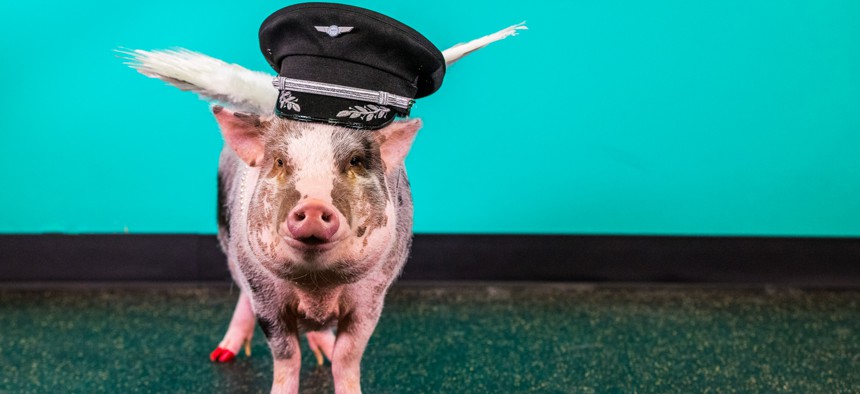Missed Your Flight? At Some Airports, Therapy Animals Are There to Help

LiLou, a Juliana-breed pig, is a member of San Francisco International Airport's Wag Brigade. San Francisco International Airport
San Francisco is one of more than 50 airports with an in-house team of certified therapy animals that roam the terminals, offering comfort and distraction to weary travelers.
On Wednesday, 11 of San Francisco International Airport’s most frequent visitors gathered in Terminal 1B for a holiday photo shoot. Toby, a golden doodle, was there. So were Cavalier King Charles Spaniels Brody and Prancer. Jagger D’Wagger, another golden doodle, made an appearance, as did Bombay, a chocolate Lab, and Benga!, a Peke-a-Poo-Tzuzu.
The pups, wearing blue vests emblazoned with the words “PET ME!,” attracted a lot of attention from travelers. That is, of course, the point.
The dogs are members of the SFO Wag Brigade, a troupe of 21 certified therapy dogs—and one therapy pig— who trot throughout the airport's terminals, offering weary travelers a chance to stop and play. The volunteer program, a partnership between the airport and the San Francisco SPCA, launched six years ago as a way to “make the travel experience more enjoyable,” said Doug Yakel, a spokesman for SFO.
“Air travel is stressful, and being at the airport can be a stressful experience,” he said. “We were interested in a program that would help reduce those stress levels, and help people relax and enjoy their time at the airport a little bit more.”
Therapy dogs have traditionally visited hospitals and retirement homes to bring joy and distraction to patients and residents. After 9/11, the San Jose International Airport brought in therapy dogs to soothe anxious passengers, and since then, at least 58 airports have started their own animal programs.

In 2013, airport officials in San Francisco were interested in joining the pack, but lacked the expertise to recruit qualified dogs on their own, Yakel said. So they reached out to the local SPCA, which offers an animal-assisted interactions, or AAI, certification program for suitable pets and their handlers. The program begins with basic training commands (sit, stay, down) and progresses to on-site training at traditional therapy locations, including retirement homes and hospitals.
“What we’re looking for in therapy pets is an animal that is interested in meeting people, that is confident about meeting people, and that has no history of aggression, snapping or growling,” said Jennifer Henley, manager of the AAI program at the SPCA. “For animals that go to the Wag Brigade, we look for a little bit more.”
Wag Brigade pets have to be particularly good at crowd management, as they typically get “mobbed” in the terminal, Henley said. The SPCA also looks for certain characteristics in the animals’ handlers, including a dedication to volunteering at the airport (getting in and out requires more hassle than serving at a hospital or retirement home) and a particular connection with each pet.
“Airports are stressful for passengers, but airports are also stressful for dogs and a pig,” Henley said. “We need to know that the handler respects the pet’s stress level or need to toilet or get a drink, or any number of other things. We want to be certain that when we send a team out into the field, especially into a high-profile program like the Wag Brigade, that we’re picking handlers and pets and are interested and are going to succeed.”
Henley estimated that the SPCA refers one to two teams per month to the Wag Brigade program. There are 21 active teams currently, enough to staff the airport nearly every day of the week. All of the brigade members are popular, Yakel said, but LiLou, a Juliana-breed pig, attracts a considerable amount of attention.
The 5-year-old, 100-pound pig—the first pig in the world to be certified for airport therapy—trots through the terminal on red-painted hooves and loves taking selfies, according to her owner, Tatyana Danilova, who joined the program after seeing how happy people were when they spotted LiLou out and about in San Francisco.
“I would be walking with her on the street, and seeing the reaction people were having—both locals and tourists—was just incredible,” she said. “They were very happy. They would often say it made their day or their trip to San Francisco.”
Danilova wanted to spread that joy, so she enrolled LiLou in the certification program at the SPCA. LiLou sailed through the training—pigs are intelligent, emotional and enjoy attention and activity, according to researchers—though she proved to be somewhat of a distraction to her canine classmates.
“The dogs were appropriately curious,” Henley said, “and she was appropriately unfazed.”
LiLou graduated from the therapy program in November 2015 and began visiting the airport in 2016. Like other Wag Brigade members, LiLou announces ahead of time where she’ll be (usually somewhere in terminal 3, as the carpet there is easier on her feet), which gives allergic passengers, or those who just don’t like dogs or pigs, the chance to steer clear. The animals are well behaved and won’t approach anyone who doesn’t first approach them, Yakel said. The airport has never received a complaint about the brigade’s presence in the terminal.
“Handlers understand that not every traveler is going to be interested in interacting,” he said. “Typically, they’ll position themselves in a high-visibility area and let the travelers approach them. They’re not inserting themselves into a condensed area.”
Travelers that choose to stop and play reap the proven benefits of animal interaction, Henley said, including reduced blood pressure, depression, and anxiety.
“We have a lot of people who are stressed about a delay or a cancellation or a rerouting. We have people nervous about flying, and people who are flying under unfortunate circumstances—a death in the family or something else distressing,” she said. “We come in and we’re able to provide something unique to passengers in this setting—the unconditional love and acceptance and joy that a dog, or a pig, can bring.”
The program benefits the animals and handlers, too, Danilova said.
“People come over and just pet her. They take a lot of photos—we call them ‘pigtures,’” Danilova said. “For LiLou, it’s an interesting experience. There are new smells, she wags her tail, she is excited. She does enjoy being out and about, she loves being photographed and she knows when the camera is on her. But I would say it really adds a huge effect for me as well. I know that I can make a difference in people’s lives—it brings me in that moment, in the interactions we’re having with people and really just gives me that feeling of gratitude that I have her in my life and how incredible that she is in my life, and she brings that to other people as well.”
Kate Elizabeth Queram is a Staff Correspondent for Route Fifty and is based in Washington, D.C.

NEXT STORY: Efforts To Move The Needle On Flu Shot Rates Get Stuck





